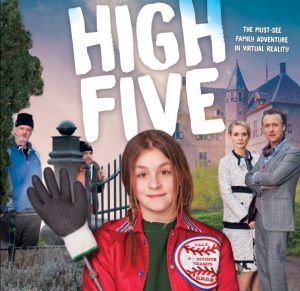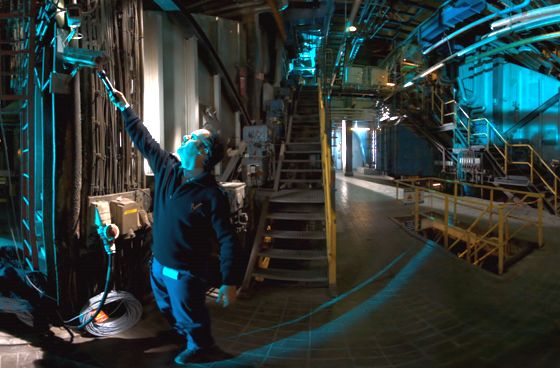'As if you were standing among the actors.' At the time, that was the slogan with which 3D was touted as a novelty in cinema. In practice, this turned out to be much to be disapproved of, but virtual reality (VR), which is now booming, still delivers on that promise. As seen, for example, in the VR film Ashes to Ashes, awarded the Dutch VR Award for best 'immersive' 360-degree film.
Since last week, this short tragicomedy has been available via the app from AVROTROS, We Share VR and Jaunt VR watch at home. Two other Dutch feature film experiments will follow soon. The Night Watch with its own app, after which in the second half of April High Five will premiere at Amsterdam's VR Cinema. Projects that demand international attention. Read why the quirky Dutch do it so well here. (tip: break the rules)
A solid puzzle
Three feature films, that's still pretty special in the VR world. Some even doubt that this new medium does lend itself to storytelling. The screenplay of Ashes to Ashes was written by Anne Barnhoorn (Golden Calf for Aanmodderfakker) and that was, in her own words, a tough puzzle. Watching a large number of VR productions in preparation, she soon realised that it was often very strong visually but that a real story was usually missing. "Whereas the screenplay is very important to me, so that seemed like a fun challenge."
Anyone who has such a goggle-like VR viewer set up is teleported to another world, so to speak. The film, if you want to call it that, is all around you. Look up or turn around, there is something to see everywhere. It could be an experimental animation you are floating around in (DEEP), a training situation for people with street fear, or an African village recovering from Ebola, as in the VR documentary Waves of Grace. But that particular overall experience also means that the traditional storytelling techniques that a feature filmmaker grew up with are largely unusable in VR. A close-up does not exist in VR, and editing is also tricky. It sometimes seems that VR and story bite each other, but surely not everyone agrees.
A mix of theatre and film

Jip Samhoud, founder of &samhoud media and producer of High Five, believes that feature film and VR can indeed go together. "Because VR is a different medium, we have to reinvent how it works. I do think it can be done, but you have to compare it to a mix of theatre and film." He has just returned from the US and found that VR makers everywhere are running into the same questions.
Much of the work is still at the experimental stage, but he also sees the importance of attracting talent. With good writers, directors and actors, it soon reaches a higher level.
Frank Lammers is at High Five director and lead actor, and Daan Schuurmans and Bracha van Doesburg also participate. It will be a short family film (about 20 minutes) with lots of humour, inspired by Home Alone, a film Jip Samhoud has fond memories of. Lammers plays one of the two villains who here target a genius young inventor's high-five machine.
One of the problems the makers had to solve is focusing the viewer's attention during the chases through the castle. You can do a lot with sound and it also works psychologically. When you see someone startled you automatically follow their gaze. The film does consist of a montage of several scenes in different locations, but each scene in itself is recorded in one take that can last a few minutes. For the actors, this is close to theatre.
The viewer's location
A key question with VR is also how to give the viewer a natural place. Does it get involved in the action, or does it remain more of a spectator. High Five chose the latter.
In the surreal tragicomedy Ashes to Ashes the viewer stands in a houseboat among bickering family members who are deeply troubled by their late father's last wish. Again, it is like being on stage among the actors at a theatre performance. "But the difference is still that you can't really join in or say anything back. That can be disturbing," Anne Barnhoorn believes. "That's why I made sure that in Ashes to Ashes takes the place of the urn containing the deceased's ashes. So it makes sense that you don't have to say anything back when you are addressed."
Play with reality

As a prelude to the final 10-minute film, Barnhoorn wrote an opening scene that was then filmed by three different directors at the 2015 Dutch VR Days. Those three versions were very instructive for Barnhoorn. "For example, I had too much dialogue, and that doesn't work if the viewer can just look around," he says. To make the story as visual as possible, I came up with the pillow fight, among other things. But directing the viewer's attention remains difficult. You can do a lot with sound, but there is still a chance you might miss something because you were just looking in a different direction. If you see the film more often, you can discover new things again. It is still unexplored territory."
One of the surprises of Ashes to Ashes is that halfway through, the set is suddenly raised so that we can see the film crew. That play with two levels of reality was not yet in Barnhoorn's script, but was added by the directors (Ingejan Ligthart Schenk, Steye Hallema, Jamille van Wijngaarden). On the one hand, Barnhoorn thinks this visual experiment was very cleverly done and she is proud of the overall result. Still, her own priority remains with the screenplay. Because all those visual finds demand a lot of attention, the story is a bit harder to follow. She does find that unfortunate.
Breaking the rules
A strong example is that it is the makers of Ashes to Ashes managed to shoot the entire film, apart from the title role but including all the ingenious set and scene changes, in one take.

This seems to support the contention that you should rather not edit in a VR film. This is precisely why it is nice to see, by way of contrast, how Maarten Treurniet (The Heineken kidnapping) has engaged with his The Night Watch doesn't care about that prescription. In this thrilling short film with a creepy twist, a dozing night watchman suddenly jerks up and goes in search of an intruder. His wandering through the haunted factory complex is relatively traditionally edited, and it turns out to be excellent. If any slight disorientation occurs, it suits the subject matter just fine.
Treurniet: "At the presentation at the Dutch VR Days, most reactions were enthusiastic. Only two VR experts were angry because I had supposedly not followed the rules and in the film you were given little time to look around. But rules are there to be broken."
Producer Bas Pinkse of 25 FPS Commercial Production sees The Night Watch as an experiment with the aim of giving the VR film more depth. "A film with a head and a tail. It was a fun journey of discovery and a good fight." He also touts the added value of a good cameraman and hopes the end result will stand out.
The torch
Director Treurniet, who also wrote the screenplay of The Night Watch wrote, believes that VR film, like 3D, needs to move beyond the stage of effects chasing. "We have yet to figure out how this new visual language works. I think you can edit quite well, but you have to be careful when cutting that the viewer's focus doesn't jump. I also use the guard's torch to focus the viewer's attention."
What, of course, helps make it clear is that there are in The Night Watch only one actor (Guy Clemens) and that the viewer is not addressed.
Asked about the added value VR offers, Treurniet mentions the role the location plays in addition to the strong feeling of being really present. "Which is like a character in the film," he says. The Night Watch has been turned at waste disposal Rijnmond.
Which stories lend themselves ideally to VR, Treurniet does not yet dare to say. But: "A drama in an enclosed space, such as a plane hijacking, would lend itself well to it. I am also thinking of a film like Ocean's Eleven. We wanted to know if it could be done. Now we have to follow through."
Ashes to Ashes can be viewed via the apps of AVROTROS and other partners of producer Submarine Channel.
The app for The Night Watch will be available in a few weeks via Google Play.
High Five is expected around the end of April in the VR Cinema in Amsterdam, later also in other places.
